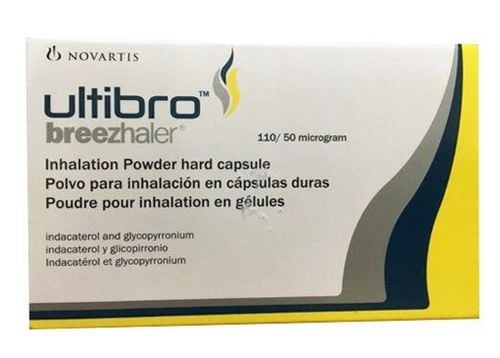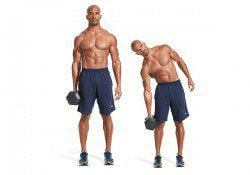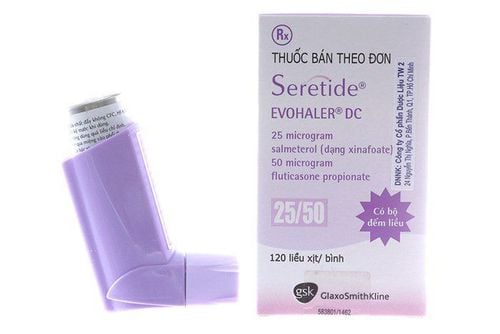This is an automatically translated article.
When you have chronic obstructive pulmonary disease (COPD), the more you hesitate to exercise, the worse the condition of your respiratory system. The poor condition of the respiratory system makes it difficult to breathe even when shopping or cooking. Exercises can help you with that. As the respiratory muscles get stronger, you will feel more comfortable to enjoy your daily life.
1. The Best Exercises for People with COPD
Here are the 10 best exercises for people with COPD you can refer to.
1.1.Walking exercise Everyone with chronic obstructive pulmonary disease can exercise. Walking is a great option, especially if you're a beginner. Walk anywhere, such as outdoors, in a shopping mall, or on a treadmill. Getting started can be difficult, but start with the smallest steps, gradually increasing it even by just 30 seconds or 1 meter per day. Even a slow pace will be good for your health. If you haven't been active lately, consult your doctor before starting an exercise program.
1.2. Cycling Exercises Cycling at home on a stationary bike is very helpful for people with chronic obstructive pulmonary disease (COPD). You can choose to cycle in your own private home, or train under the supervision of professionals and meet friends while working out at the gym or rehabilitation facility. Ask an instructor before joining a cycling club to make sure it's right for you. As you progress, try going outside on a traditional bike. If any exercise leaves you out of breath, stop and rest for a few minutes.
1.3. Forearm biceps exercises Light weight lifting exercises can help you perform everyday tasks like reaching for overhead shelves or carrying a few liter cartons of milk with ease. Choose dumbbells, elastic bands or water bottles with the right weight to work your biceps. When using these supplemental weights, you can refer to the following exercise:
Hold dumbbells (or other similar weights) in front of your body, elbows slightly extended, palms facing first, inhale. Contract the dumbbells towards your chest, bend your elbows, and exhale slowly. Repeating two steps of the movement continuously, performing up to two sets, each set 10-15 times will help people with chronic obstructive pulmonary disease improve their health and make it easier to perform daily activities.

Người bệnh phổi tắc nghẽn mạn tính có thể tập luyện các bài tập cơ tay trước
1.4. Shoulder and upper arm exercises Hold weights along the sides of your body, palms facing in, inhale. Then exhale slowly and raise your arms forward, to shoulder height. Inhale slowly and lower your arms back to the starting position. This exercise helps increase the strength and endurance of the shoulders and upper arms. Perform the exercise 2 sets, each set 10-15 times. Start with light weights and increase the weight every 2 to 3 weeks to stimulate muscle growth in people with chronic obstructive pulmonary disease.
1.5. Exercises for the leg muscles Creating a habit of exercising the leg muscles helps people with chronic obstructive pulmonary disease to walk more easily and further. For the calf push-up exercise, stand behind a sturdy chair 15 to 30 centimeters away with your feet hip-width apart. Keeping your balance, inhale, raise your heels to high toe to maintain contact with the ground, exhale slowly. Hold the raised position briefly, then lower your heels to the ground, inhaling slowly. When you feel your health improves, you can increase the difficulty by training each leg separately, doing two sets of 10-15 times each.
1.6. Anterior thigh kick exercise People with chronic obstructive pulmonary disease who want to increase the strength of their thighs, sit on a chair with a backrest. Starting the movement, the practitioner inhales and then exhales slowly, while straightening one leg as much as possible, without locking the knee, then slowly lower the leg back to the floor and inhale. Do one set with the right leg, then with the left leg. If the exercise feels too easy, the practitioner can use more weight at the ankle. Do two sets of 10-15 reps each.
1.7. Exercise for the diaphragm This exercise strengthens the most important respiratory muscle that is the diaphragm. Start by lying on your back, knees bent, feet flat on the ground, or sitting on a chair, one hand on your chest, one hand under your ribs. Inhale slowly through the nose so that the abdomen lifts one hand below the rib cage. Exhale through your mouth with your lips half-closed and your stomach pulled in. The hand on your chest should not move. People with chronic obstructive pulmonary disease should do it for 5 to 10 minutes, three or four times a day. Practicing in this way will become increasingly easy and automatic.
1.8. Chair Dancing If you enjoy an art like dance, try this chair dance in class or with DVDs at home. Different programs can help increase your cardiovascular performance, strengthen your muscles, or both. Beginners can start with a class to learn the safest body movements. When familiar with the intensity of exercise, people with chronic obstructive pulmonary disease can add dumbbells to increase their strength.
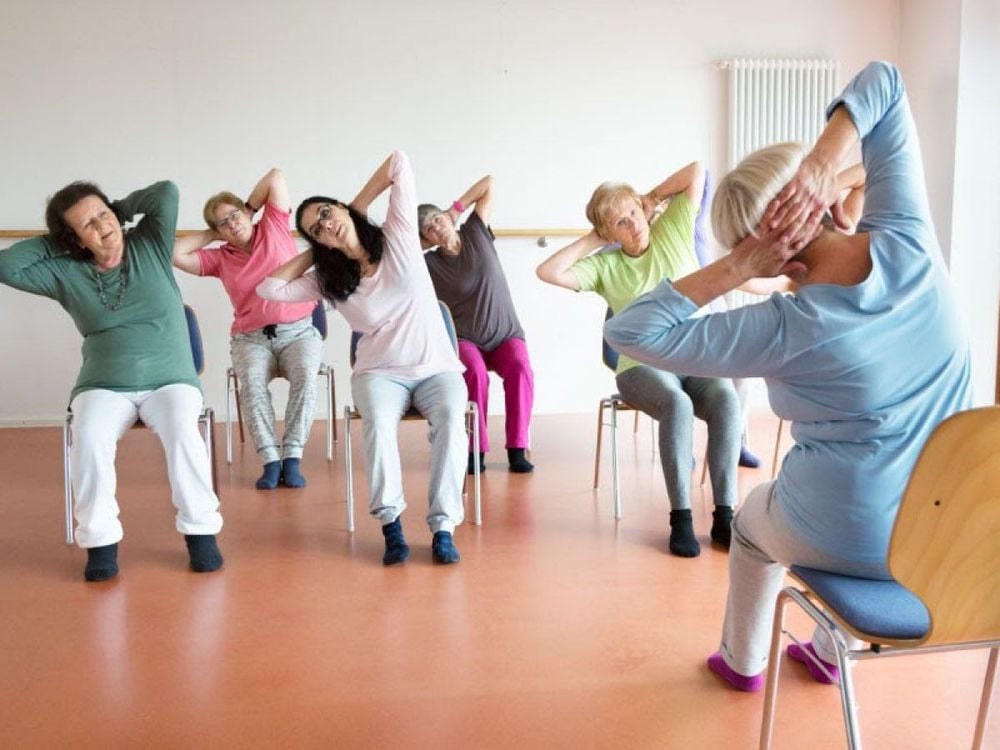
Người bệnh phổi tắc nghẽn mạn tính có thể tham khảo các bài tập của bộ môn múa ghế
1.10.Breathe properly for better results Breathe slowly during exercise. Inhale through your nose, keeping your mouth closed, to warm and filter the air. Exhale through your mouth twice as long as it takes to inhale. Panting should not be done, as this makes the lungs less efficient at using oxygen and unable to expel all the residual air, a condition that is inherent in people with chronic obstructive pulmonary disease. If the respiratory rate is fast or shallow during exercise, stop and rest. Relax your body, perform pursed-lip breathing, inhale through your nose and exhale slowly out through your mouth while your lips are slightly closed.
1.11.Strength exercises Performing gentle stretching exercises before and after training helps optimize training efficiency and better recovery. People with chronic obstructive pulmonary disease can apply the following exercises: Stretch your arms straight ahead, raise them to shoulder height, and put your hands on the wall. Step your right foot forward and bend your knee until you feel a slight stretch in your calves for 10 to 30 seconds (don't be so tight that it hurts). Do the same with the left leg, alternating legs 3-5 times each time.
1.12.Try a new exercise Running, skating or rowing can be good exercises for people with mild chronic obstructive pulmonary disease and are fun ways to avoid the boredom of a workout. Some novel ways of being active like water aerobics are great for chronic obstructive pulmonary disease (COPD) and arthritis. If the patient has not practiced these exercises, attend a pulmonary rehabilitation program in a specialized care facility or consult a physician to ensure health safety. Some people may need to avoid pushups, squats, or heavy lifting.
1.13.Use oxygen support during exercise If people with chronic obstructive pulmonary disease use oxygen during exercise, they may feel worried that the equipment will cause danger or trouble. However, if your doctor recommends using oxygen during exercise, do it and these devices are suitable for most types of exercise. Patients with chronic obstructive pulmonary disease can choose fixed or mobile oxygen support equipment depending on their exercise habits.
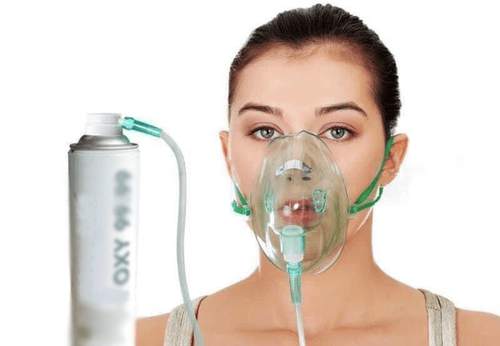
Một số loại thiết bị hỗ trợ oxy di động phù hợp với người bệnh phổi tắc nghẽn mạn tính
2. When should you not exercise?
Give yourself a day off if chronic obstructive pulmonary disease symptoms are evident: wheezing , coughing up more phlegm than usual or unusual shortness of breath. Also, call for help right away if your shortness of breath doesn't improve, your heart beats fast or irregularly, and you feel dizzy or light-headed.
In addition, you should also practice regularly so that practice becomes a habit. The goal for most people is to get 20 to 30 minutes of exercise a day, at least three times a week, that includes cardio and strength training. People with chronic obstructive pulmonary disease have more of a problem, so start a level that works for you even if it's only for a minute. You can maintain and form a practice habit by:
Find a companion with similar exercise interests. Integrate your exercise program into your daily routine. Keep an exercise diary - and make notes when you feel better in your daily activities. In summary, people with chronic lung disease should perform physical activities, gentle exercise, and moderate strength to ensure health. Hope the above exercises will be a good choice for you.
Follow Vinmec International General Hospital website to get more health, nutrition and beauty information to protect the health of yourself and your loved ones in your family.
Please dial HOTLINE for more information or register for an appointment HERE. Download MyVinmec app to make appointments faster and to manage your bookings easily.
Reference source: webmd.com




